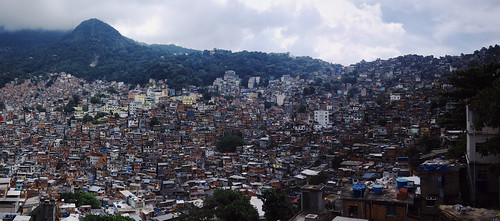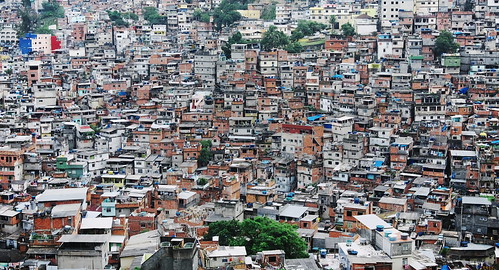This morning involved a visit to Favela Rocinha, which I believe is Brazil's largest favela (which translates most directly to “slum”). I took a tour* through a local organization that supposedly reinvests some earnings back into the favela community. This could be a front to appease the guilt-ridden tourist who thinks photographing the urban poor is in bad taste (which it kind of is). But the favelas represent a growing reality in Brazil and many other parts of the world. So learning more about them and how the communities develop is little different in my mind than driving out into the suburbs (or into the city) to see how the other half lives.
And I am glad I did, as it was amazing. Rocinha has some 200,000 residents nestled in between sweeping hills (more like mountains) on three sides. The tour started by hopping onto the back of a motorcycle and booking it up to the top of the hill. Which would certainly have been worth the price of the tour in itself. There are few things as exhilarating as riding a motorcycle through a congested favela, swerving around delivery trucks, piles of rubble/garbage, other motorcycle taxis, and chickens.
From there, we proceeded to walk down through the favela, passing by a wide variety of shops and people, all within narrow passageways, most of the time less than a meter wide (and on a slope). Suffice it to say, inside the favela, it's very hard to tell where you are and what's what, until you break through again and see the sky or a view across the whole thing.
As with all of the favelas and other informal communities, running water, sewage, garbage collection and electricity are all problematic within Rocinha. However, the size of Rocinha is now its greatest ally, as the city can no longer displace these residents (there are just too many) so instead, Rio is starting to provide services to the favela, such as running water and electricity. Sewage removal relies on gravity, so you can guess those that live lower are the poorest. I didn't see much evidence of garbage collection, though I barely saw a minor portion of the favela, really.
Favela Rocinha is just massive (though not for how many people it houses). The way it grows over the hills and wipes out all traces of the land except for the slope is awesome (ie, inspiring awe, not necessarily good). This is megastructure, though not nearly as clean and rational as envisioned by the megastructuralists.

Favelas in Brazil are growing faster than the rest of the city, for which there are several reasons: first, the poor tend to out-breed the wealthy, which is rather well-known and documented; and second (and more interesting) is that more and more people choose to live in the favelas because it is so much cheaper. See, the people in the favelas pay no taxes, “borrow” electricity, can find running water in the streets (there are open taps for anyone to get water, thanks to the new services provided by Rio) and are in prime locations for service jobs (the nearby wealthy areas of Zona Sul). It's not the american dream, but it's a living for a growing number of people.
Though there is the problem of living in an area controlled by drug cartels. For example, when two drug cartels battle over territory, they do so in the favela. And when the police want to weaken a cartel (not remove, mind you), they arrive en masse with 400 – 500 heavily armed police officers and have shootouts across the favela. (Interesting side note: the police always arrive just after dawn, storm the city, and leave by dark, as the favela is too hard and dangerous to navigate at night.)
According to my illustrious guide, Favela Rocinha generates $2 million (US) a month for the cartels, which then goes (mostly) towards better weapons, bribing police, and producing more drugs. On the bright side, the current cartel in Rocinha has banned crack-cocaine, as it degrades the community (high is too short and expensive, leading to people robbing each other to get high again). Shades of grey.
Got all that?
Let me also mention that I did the most typical first-world tourist thing: photographed a seemingly-happy-but-poor child for some pocket change. I am even slightly ashamed to admit it, but it happened...(twice).
*Going there by myself seemed less than prudent, as the favelas are controlled by drug cartels and lone tourists tend to stand out.

Hey:
ReplyDeleteI came across this today:
http://www.thedonutproject.com/2010/06/10/favela-painting/?utm_source=feedburner&utm_medium=feed&utm_campaign=Feed%3A+TheDonutProject+%28The+Donut+Project%29
Interesting project.